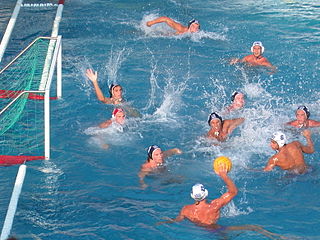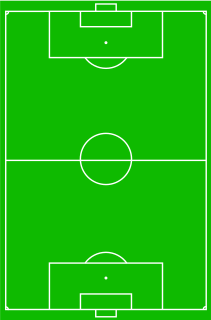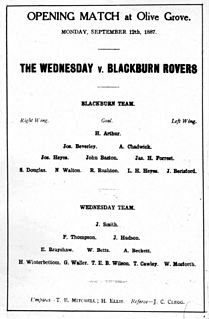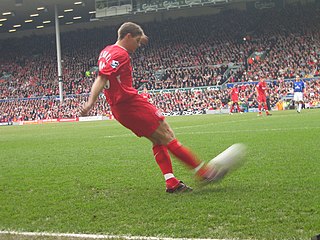
Handball is a team sport in which two teams of seven players each pass a ball using their hands with the aim of throwing it into the goal of the other team. A standard match consists of two periods of 30 minutes, and the team that scores more goals wins.

Water polo is a competitive team sport played in water between two teams of seven players each. The game consists of four quarters in which the two teams attempt to score goals by throwing the ball into the opposing team's goal. The team with the most goals at the end of the game wins the match. Each team is made up of six field players and one goalkeeper. Excluding the goalkeeper, players participate in both offensive and defensive roles. Water polo is typically played in an all-deep pool so that players cannot touch the bottom.

The penalty area or 18-yard box is an area of an association football pitch. It is rectangular and extends 16.5m to each side of the goal and 16.5m in front of it.

A midfielder is an association football position. Midfielders are generally positioned on the field between their team's defenders and forwards. Some midfielders play a strictly-defined defensive role, breaking up attacks, and are otherwise known as defensive midfielders. Others blur the boundaries, being more mobile and efficient in passing: they are commonly referred to as deep-lying midfielders, play-makers, box-to-box, or holding midfielders. The number of midfielders on a team and their assigned roles depends on the team's formation; the collective group of these players on the field is sometimes referred to as the midfield.

The centre in ice hockey is a forward position of a player whose primary zone of play is the middle of the ice, away from the sideboards. Centres have more flexibility in their positioning and are expected to cover more ice surface than any other player. Centres are ideally stronger, faster skaters who can back-check quickly from deep in the opposing zone. Generally, centres are expected to be gifted passers more than goal scorers, although there are exceptions, typically larger centres who position themselves directly in front of the net in order to score off rebounds. They are also expected to have exceptional "ice vision", intelligence, and creativity. They also generally are the most defensively-oriented forwards on the ice. Centres usually play as part of a line of players that are substituted frequently to keep fresh and keep the game moving.
In the sport of association football, a defender is an outfield player whose primary roles are to stop attacks during the game and prevent the opposing team from scoring goals.
There are various individual skills and team tactics needed to play effective association football. Football is in theory a very simple game, as illustrated by Kevin Keegan's famous assertion that his tactics for winning a match were to "score more goals than the opposition". However, well-organised and well-prepared teams are often seen beating teams with supposedly more skillful players, even over time. Coaching manuals and books generally cover not only individual skills but tactics as well. Some of the tactics include using a 4-4-2 formation which is often regarded as the standard formation, a formation of 5-4-1 which is more defensive and a 4-3-3 formation which allows for more attacking play.

In association football, the formation describes how the players in a team generally position themselves on the pitch. Association football is a fluid and fast-moving game, and a player's position in a formation does not define their role as rigidly as for, for instance, a rugby player, nor are there episodes in play where players must expressly line up in formation. Nevertheless, a player's position in a formation generally defines whether a player has a mostly defensive or attacking role, and whether they tend to play towards one side of the pitch or centrally.

In the sport of association football, each of the 11 players on a team is assigned to a particular position on the field of play. A team is made up of one goalkeeper and ten outfield players who fill various defensive, midfield, and attacking positions depending on the formation deployed. These positions describe both the player's main role and their area of operation on the pitch.
In sports, a utility player is one who can play several positions competently. Sports in which the term is often used include association football, American football, baseball, rugby union, rugby league, softball, ice hockey, and water polo.

In sports, a starting lineup is an official list of the set of players who will participate in the event when the game begins. The players in the starting lineup are commonly referred to as starters, whereas the others are substitutes or bench players.

Like most forms of modern football, rugby league football is played outdoors on a rectangular grass field with goals at each end that are to be attacked and defended by two opposing teams. The rules of rugby league have changed significantly over the decades since rugby football split into the league and union codes. This article details the modern form of the game and how it is generally played today, however rules do vary slightly between specific competitions.

The goalkeeper, sometimes shortened to keeper or goalie, is one of the major positions of association football. It is the most specialised position in the sport. The goalkeeper's primary role is to prevent the opposing team from scoring. This is accomplished by the goalkeeper moving into the path of the ball and either catching it or directing it away from the vicinity of the goal line. Within the penalty area goalkeepers are able to use their hands, making them the only players on the field permitted to handle the ball. The special status of goalkeepers is indicated by them wearing different coloured kits from their teammates and the opposition.
The following terms are used in water polo. Rules below reflect the latest FINA Water Polo Rules.
In association football, a playmaker is a player who controls the flow of the team's play, and is often involved in offensively and defensively play passing moves which lead to goals, through their vision, technique, ball control, creativity and passing ability.
This is a list of common terms used in ice hockey along with the definition of these terms.

The following are the positions in the Gaelic sports of Gaelic football, hurling and camogie.
This list of rugby league terms is a general glossary of the terminology used in the sport of rugby league football. The sport has accrued a considerable amount of jargon to describe aspects of the game. Many terms originate from the Laws of the Game. A number of aspects of the game have more than one term that refers to them. Different terms have become popularly used to describe an aspect of the game in different places with notable differences between the northern and southern hemispheres.

In association football, a cross is a medium- to-long-range pass from a wide area of the field towards the centre of the field near the opponent's goal. Specifically, the intention of a cross is to directly bring the ball into the box from an angle that allows the attacking forwards to more easily aim for goal with their head or feet. Crosses are generally airborne (floated) to clear nearby defenders, but can also be hit with force along the ground (drilled). It is a quick and effective move.

Futsal began in the 1930s in South America as a version of association football, taking elements of its parent game into an indoor format so players could still play during inclement weather. Over the years, both sports have developed, creating a situation where the two sports share common traits while also hosting various differences.












